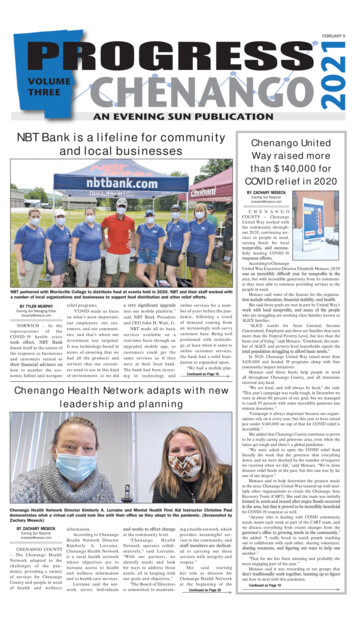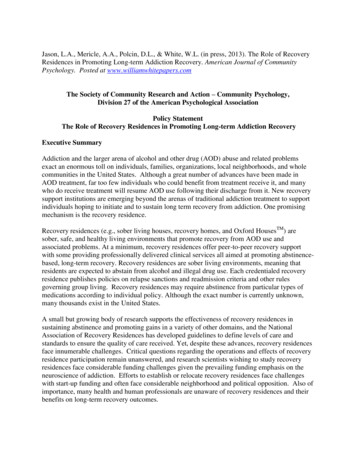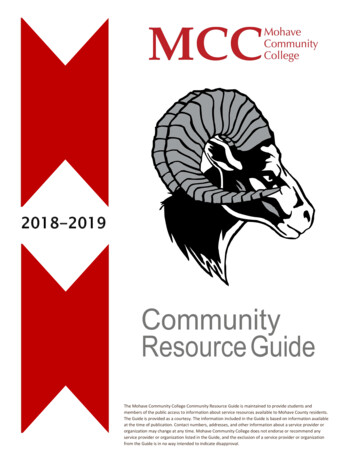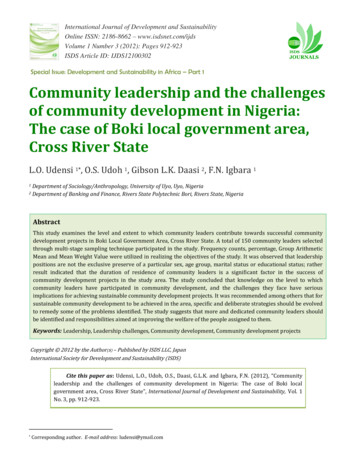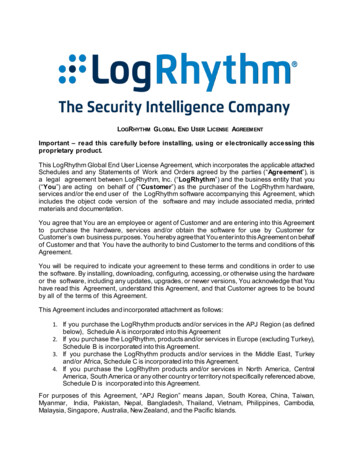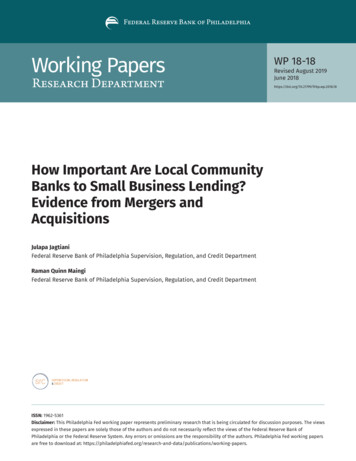
Transcription
Working PapersWP 18-18Revised August 2019June 2018https://doi.org/10.21799/frbp.wp.2018.18How Important Are Local CommunityBanks to Small Business Lending?Evidence from Mergers andAcquisitionsJulapa JagtianiFederal Reserve Bank of Philadelphia Supervision, Regulation, and Credit DepartmentRaman Quinn MaingiFederal Reserve Bank of Philadelphia Supervision, Regulation, and Credit DepartmentISSN: 1962-5361Disclaimer: This Philadelphia Fed working paper represents preliminary research that is being circulated for discussion purposes. The viewsexpressed in these papers are solely those of the authors and do not necessarily reflect the views of the Federal Reserve Bank ofPhiladelphia or the Federal Reserve System. Any errors or omissions are the responsibility of the authors. Philadelphia Fed working papersare free to download at: ications/working-papers.
How Important Are Local Community Banks to Small Business Lending?Evidence from Mergers and AcquisitionsJulapa Jagtiani *Federal Reserve Bank of PhiladelphiaRaman Quinn MaingiFederal Reserve Bank of PhiladelphiaAugust 2019AbstractWe investigate the shrinking community banking sector and the impact on local small businesslending (SBL) in the context of mergers and acquisitions. From all mergers that involved communitybanks, we examine the varying impact on SBL depending on the local presence of the acquirers’ andthe targets’ operations prior to acquisitions. Our results indicate that, relative to counties where theacquirer had operations before the merger, local SBL declined significantly more in counties whereonly the target had operations before the merger. This result holds even after controlling for thegeneral local SBL market or local economic trends. These findings are consistent with an argumentthat SBL funding has been directed (after the mergers) toward the acquirers’ counties. We find evenstronger evidence during and after the financial crisis. Overall, we find evidence that localcommunity banks have continued to play an important role in providing funding to local smallbusinesses. The absence of local community banks that became a target of a merger oracquisition by nonlocal acquirers has, on average, led to local SBL credit gaps that were not filledby the rest of the banking sector.Keywords: community banks, small business lending, bank mergersJEL Classifications: G21, G28, G34Please direct correspondence to Julapa Jagtiani, Federal Reserve Bank of Philadelphia, Supervision,Regulation, and Credit Department, Ten Independence Mall, Philadelphia, PA 19106; 215-574-7284; emailjulapa.jagtiani@phil.frb.org. The authors thank Jason Schmidt for his data support. Special thanks to RonFeldman, Paul Calem, Silvio Rendon, Larry Wall, Ettore Croci, Joe Hughes, and participants at the EFMAconference, the World Finance Conference, and the Federal Reserve Community Bank Conference for theirvaluable comments and suggestions.*Disclaimer: This Philadelphia Fed working paper represents preliminary research that is being circulated fordiscussion purposes. The views expressed in these papers are solely those of the authors and do notnecessarily reflect the views of the Federal Reserve Bank of Philadelphia or the Federal Reserve System. Anyerrors or omissions are the responsibility of the authors. No statements here should be treated as legaladvice. Philadelphia Fed working papers are free to download at cations/working-papers.1
I.IntroductionSmall businesses are believed to play a significant role in local communities as they contribute tothe local economic growth. They account for roughly half of private employment and more than halfof total economic output; see Laderman (2008). Further, small businesses and startups aredisproportionately responsible for job creation; see Neumark, Wall, and Zhang (2011), Haltiwanger,Jarmin, and Miranda (2013). To continue to play their critical roles in stimulating the localeconomy, small businesses are dependent on their ability to access funding as needed. Drechsler,Savov, and Schnabl (2017) show that their declines in access to funding would depress long-termeconomic and employment growth. Thus, maintaining the functionality of the market for smallbusiness lending (SBL) is important to economic growth.Community banks traditionally served as the primary source for small businesses’ fundingneeds. Lending to small businesses often involves unique challenges since small firms and localstartups tend to be opaque because of their short credit histories. Thus, SBL originations relyheavily on relationship-based lending and “soft” information, as discussed in Petersen and Rajan(1994), Berger and Udell (1995), and Cole (1998). Conventional wisdom suggests that communitybanks have a comparative advantage over large banks in collecting soft information and inrelationship lending, leading to a comparative advantage in SBL funding to local small businesses.Local markets and geographic proximity seem to be important in SBL, according to Berger andDeYoung (2001) and Nguyen (2017). Community banks’ outsized role in SBL origination bolstersthe economic importance of the community banking sector in the U.S. economy.In contrast to the traditional paradigm, recent SBL trends suggest a new banking landscapein which large banks have become more active in providing funding to small businesses. Followingthis trend, large banks increasingly used credit scoring methods for small business borrowers(Berger and Frame (2007)). This technique helped bridge the gap of SBL between large and smallbanks. Peterson and Rajan (2002) noted increasing distance between small business borrowers andlenders as a result of changes in lending technologies such as the adoption of credit scoringtechnologies by the lending banks. Jagtiani, Kotliar, and Maingi (2016) show that, within thebanking sector, large banks have doubled their market shares in SBL over the last decade. Thisevidence is consistent with a shift from relationship-based to formula-based underwriting for SBLas shown in Berger, Frame, and Miller (2005) and Berger, Cowan, and Frame (2011). Similarly,Jagtiani and Lemieux (2016) and Laderman (2008) find that large banks have been able to reachsmall businesses outside of their local markets (where they do not have any physical presence) inrecent years, taking the SBL share from local community banks. We suspect that the impact of these2
changes may not be occurring evenly across markets and geographical location, but thedistributional implications of these changes in the SBL landscape have not been well studied. Weexamine whether certain local markets may be disproportionately impacted.In this paper, we explore the interplay among community banks’ comparative advantages inSBL, their local presence, and their involvement in mergers and acquisitions (M&As). Our previousstudy in Jagtiani, Kotliar, and Maingi (2016) find that as community banks become larger (throughmergers and acquisitions), the combined banking firm actually increased its lending to smallbusinesses overall after the mergers (compared with the combined amount of SBL that the targetand the acquirer originated prior to the merger). The results are even stronger when the acquiringbank is a large bank (larger than 10 billion in assets). Superficially, these results suggest that thereshould be no negative impact on the overall SBL funding as the number of small community banksdeclined in recent years (through failures and bank M&A waves). However, it is quite possible that,while the overall SBL funding increased after the merger, the acquirer could have diverted SBLfunding from the target’s local community. In this paper, with additional data, we are able to lookdeeper by incorporating into the analysis the specific location (community) where small businessloans are made, i.e., whether the increase in small business loans is occurring in the target’s localcommunity (or in the acquirer’s local community) after the merger. Our results suggest that theincreased SBL funding after the merger actually occurs in the acquirer’s own community and thatthe merged banks are likely to decrease their SBL origination in the Target-Only counties (countieswhere the target has operations and the acquirer does not have operations prior to the merger).We recognize that the changes in SBL origination by banking firms involved in M&As maybe offset by other banks so there might be no net impact to the community. In addition, some newde novo banks (state banks that have been in business for less than five years) could pop up in thelocal community to fill the SBL credit gap that was created by the mergers. In this study, we accountfor these possibilities in the analysis. We explore the net impact (allowing for other banks to fill thecredit gap) by measuring the overall SBL activities in each local community and examine how thevarious types of community bank mergers that took place in the community may be related to thenet change in local SBL funding. We find that the impact on local SBL varies; in particular, there is anet decline in SBL in Target-Only counties even after accounting for the possibility that otherlenders could come in to fill the SBL credit gap. Overall, unlike in the Acquirer-Only counties, denovo banks and other banks do not fully compensate for the decline in SBL funding in the TargetOnly counties.3
Specifically, our results show that the merged (combined) banking firms are about 11percentage points more likely to decrease their SBL activity in counties where only the target wasoperating prior to the merger, compared with counties where only the acquirer was operatingbefore the merger. Furthermore, we find that reactions by other banking firms do not compensatefor this SBL decrease. This evidence is consistent with an argument that local community banks stillplay an important role in providing SBL funding to local small businesses and that losing localcommunity banks through a merger could potentially slow SBL funding availability in the localcommunity.The rest of the paper is organized as follows: Section II reviews the existing literature oncommunity bank mergers and our unique contributions to the literature. Section III describes ourdata sources. Section IV describes our identification strategy. The empirical results and ourconclusions and policy discussion are presented in Section V and Section VI, respectively.II.The Literature ReviewExisting research on community banks and SBL covers the various advantages and disadvantages ofrelationship-based lending at community banks with transaction-based lending technologies thatare more common at larger banks. There also exists a rich literature on community bank M&Aactivity and its impact on SBL markets.The first strand research argues that small community banks have a comparative advantagein certain types of lending that enable them to compete with large banks. For example, Kowalik(2014) finds that community banks have a comparative advantage in monitoring their consumersthrough relationship lending. Similarly, Berger, Cerqueiro, and Penas (2014) find that for certaintypes of informationally intensive loans, small banks had a greater volume and a lower failure rateof loans leading up to the financial crisis, but they observe a reversal of this advantage after thecrisis. Jagtiani (2008) finds that the majority of community bank mergers during 1990–2006involved community bank acquirers, rather than large banks, contrasting the narrative thatcommunity bank acquisitions are motivated by a desire to gain the efficiency of a large bank.The second strand of the literature suggests that large banks are better than communitybanks at certain important facets of SBL. Berger, Cowan, and Frame (2011) and Berger, Frame, andMiller (2005) find that, for SBL, the small business credit scores (SBCS) used by large banks aresuperior to the consumer credit scores of small business owners (used by community banks). Also,SBCS have played an important role in allowing large banks to expand their lending to small4
businesses; Jagtiani, Kotliar, and Maingi (2016) show that large banks have doubled their marketshares in SBL (within the banking sector) over the last decade.M&As are often used as a source of exogenous variation in the literature. Hastings andGilbert (2005) use M&As to study gasoline markets, and Dafny, Duggan, and Ram (2012) use M&Asto study health-insurance markets. Of particular relevance to our paper are Garmaise andMoskowitz (2006) and Nguyen (2017), who use mergers to study local banking markets. Similar tothese papers, we believe that mergers provide a useful tool to study declines in community bankingand changes in funding to local small businesses.Mergers in community banking and SBL are reflected in a rich literature. Berger, Scalise,Saunders, and Udell (1998) find that while the short-term static effects of a community bankmerger can result in a somewhat negative impact (reduction in SBL), the longer term, dynamiceffects tend to outweigh this negative impact when taking into account the reactions of local firms.This is further explained by Berger, Bonime, Goldberg, and White (2004) who find that de novobanks emerge in the local community and issue SBL to fill the credit gap. Similarly, using data from1994 to 1997, Avery and Samolyk (2004) find that, unlike large bank mergers, community bankmergers are associated with a higher overall loan growth and a greater market share of localcommunity banks; other local community banks tend to increase their own SBL following a localcommunity bank merger.Jagtiani, Kotliar, and Maingi (2016) examine community bank mergers, focusing on theimpact of acquirer characteristics on SBL activities after the merger. Overall, they find that lendingto small businesses by the merged banking firm surpasses the sum of its predecessor target andacquirer. Moreover, the authors found heightened effects when the acquirer was a large bank, withassets greater than 10 billion — implying that becoming a part of a larger banking organizationcould further expand credit access to small businesses. Consistent with these findings, Jagtiani andLemieux (2016) suggest that technological advances have recently enabled large banks to providefunding to small businesses in distant locations, taking market share from small, local communitybanks. 1It is important to note that previous research findings on community bank mergers thatincrease overall SBL volume are subject to significant geographic and time period limitations.Berger et al. (1998) used the Survey of the Terms of Bank Lending to Businesses, which is limited toabout 300 disproportionally large banking institutions. Avery and Samolyk (2004) imputeThe authors outline partnership opportunities between community banks and fintech lenders as a way toretain SBL market shares.15
geographic concentration of SBL using summary of deposit data, which may not be a good proxy forSBL activities. Perhaps the closest study in the literature is by Nguyen (2017), who uses mergers toconstruct an instrument for branch closings to study local markets’ dependencies on branches.However, Nguyen does not examine mergers generally and does not account for small communitybanks because they fall below relevant reporting thresholds. Further, studies of bank mergers areconcentrated in the period before the crisis, and their findings may no longer hold because ofsignificant changes to bank competition and cost structures in the wake of the financial crisis; seeHughes, Jagtiani, Mester, and Moon (2019) and Powell (2016). We study this question in-depth inlight of our improved data that are available for the post-crisis period.We find that there are significant negative responses to declines in community banking. Asmentioned earlier, the merged firms are more likely to decrease their SBL activity in countieswhere only the target was operating before the merger (compared with counties where only theacquirer was operating before the merger). We also find that acquirer size is important indetermining the decline in the Target-Only counties. Our results overall suggest that localcommunity banks still play an important role in lending to small businesses and that M&Asinvolving a community bank target could result in long-term declines in lending to local smallbusinesses (which are not offset by other bank lenders).III.The DataWe use data from multiple sources and appropriately merge them for various analytical purposes. First, our bank merger sample consists of all bank mergers that took place during 2002–2014 that involved U.S. community bank targets, using two different definitions of community banks.Second, our data on SBL originations (by each bank, in each county, and in each year) coverthe period from 2001 to 2015 (allowing us to analyze SBL activities for the period 12months before and after the merger that took place in 2002–2014). It is important to notethat we are able to identify the amount and the geographic location of each bank’s SBLactivities (i.e., the amount of SBL that each bank originated and purchased in each county ineach year). 2This enables us to compare the merger counterparties’ (target and acquirer) SBL activities across countiesbefore and after the mergers.26
Third, we collect information on the firms’ structures premerger and postmerger. We usethe Federal Reserve’s bank structure database, along with the SBL allocation data, toevaluate changes in SBL allocation (at the county level and at the firm level) across differentmerger types and county types. Merger types are classified by combinations of whether thetarget and acquirer have existing operations in the county: Target-Only, Acquirer-Only, or Both.Last, we use other data sources for local economic factors and general banking activities ineach county. We describe each of the data sources in more detail next.III.1Data on Bank Mergers and AcquisitionsWe collect transaction-level data on bank M&As from SNL Financial’s M&A Database. The databasecontains information about M&A targets, acquirers, and announcement/completion dates. The dataset also has financial information about the targets and the acquirers around the merger dates. Werestrict the sample to M&A transactions during 2002–2014 that involved a community bank target.We also perform a separate analysis for M&A transactions that took place before and after thefinancial crisis to allow for the possibility that the nature of SBL activities may be significantlyaffected by the financial crisis. 3We define community banks in two ways: 1) banks with assets less than 1 billion (in themain results), and 2) banks with assets less than 10 billion. 4 Our sample of community bankmergers changes according to the definition of community banks and the sample period. Our finalsamples for the entire period of 2002–2014 include 1,280 and 1,366 community bank mergerswhen the target community banks are defined as having less than 1 billion and less than 10billion, respectively. Of the 1,280 community bank mergers (for the 1 billion definition), 477mergers were completed during what we define as the post-crisis period of 2010–2014. Similarly, ofthe 1,366 community bank mergers (for the 10 billion definition), 511 mergers took place duringthe 2010–2014 post-crisis period.We exclude minority interest acquisitions, government-assisted acquisitions, asset purchases, acquisitionswith a foreign acquirer, and merger deals that had not been completed by the end of 2014.3Both of these definitions have been widely used in the literature. The 1 billion definition used to be morecommon, but the 10 billion definition has become more popular after the passage of the Dodd–Frank WallStreet Reform and Consumer Protection Act of 2010. See, e.g., Critchfield, Davis, Davison, Gratton, Hanc, andSamolyk (2004); DeYoung, Hunter, and Udell (2004); Jagtiani (2008); and Jagtiani and Lemieux (2016) for the 1 billion definition or Hughes, Jagtiani, and Mester (2016); Jagtiani and Lemieux (2016); and Rice and Rose(2016) for the 10 billion definition.47
III.2Small Business Lending (SBL) DataWe collect each bank’s SBL activities in each county and in each year from the CommunityReinvestment Act (CRA) Disclosure Reports, which contain highly disaggregated information onSBL activities (newly originated and purchased SBL) at each banking institution in each county ineach year. These data are available for all banks that exceed a size threshold that varies over time. 5Using the CRA data, we calculate, for each county in each year, a proportion of a bank’s overall SBLactivities that occur in a given year in each specific county. This calculated firm-county-year level ofthe SBL ratio is applied to the outstanding SBL volume that a bank reports in the following June CallReports. In other words, the overall SBL outstanding as of June in each year is allocated to firmcounty-level SBL activities, based on the banking firm’s SBL origination and purchase activitiesreported by the bank in the CRA reports in the previous year.For some small community banks that fall below the CRA reporting threshold, we use theirdeposit-taking location to allocate the overall SBL activities as reported in the Call Reports, 6 whichare submitted to the Federal Reserve and the Federal Deposit Insurance Corporation (FDIC) by allbanks. 7 We then geographically allocate total outstanding SBL volume into firm-county-level SBLfollowing the allocation process used in Jagtiani and Lemieux (2016). The FDIC Summary ofDeposits contains the locations and amount of deposits held at each branch of all FDIC-insuredinstitutions, which can be aggregated to the county level. We apply the geographic distribution ofbank deposits in each county to impute the annual firm-county-level SBL in each year for this groupof banks that do not submit CRA reports. 8Firms below a certain threshold size are not required to submit CRA disclosure data. The threshold for CRAreporting has changed over time; for our sample, the threshold to submit the CRA report was for banks withassets of at least 250 million during 2001–2005 and at least 1 billion of assets in 2006; the threshold wasindexed to CPI inflation after 2006. The full information on size thresholds to report the CRA data post-2006can be found on the Federal Financial Institutions Examination Council (FFIEC)’s website atwww.ffiec.gov/cra/reporter.htm.5We recognize that this method of geographically allocating SBL based on deposit taking is not perfect. Theplot in Figure A1 in the Appendix shows that deposit-taking activities for small community banks performreasonably well in estimating their SBL activities at the 5-digit zip code level.6The relevant data items are available quarterly from 2010 forward but only available yearly in the June CallReports until 2009. We collect the total outstanding SBL as of June each year for each bank for our entiresample period of 2001–2015.7Avery and Samolyk (2004) use deposit taking to allocate SBL from Call Reports regardless of whether thefirms report their actual CRA activities at the county level (from CRA Reports). Rather than applying thedeposit distribution to all sampled banks, we follow the process used in Jagtiani and Lemieux (2016) in whichthe actual CRA distribution from the CRA reports are used to allocate SBL to specific counties when the CRAdata are available. Jagtiani and Lemieux argue for this approach on the grounds that it is unlikely for smallcommunity banks to engage in material lending outside of their immediate geographic footprint. For88
III.3Branching and Bank Structure DataWe gather information on the banks’ organizational structure from the Federal Reserve StructureData, which allows us to identify the top and intermediate holders of a banking firm with detailsabout the nature of the relationships. We use these data to classify target and acquirer size based onthe top holder of each of the counterparties prior to the merger.III.4Economic FactorsWe gather information on general county-level macroeconomic indicators from the Haver Analyticsdatabase to use as control variables. The imputed SBL market concentration variables are derivedfrom the several data sources — the CRA reports, the Call Reports, and the FDIC Summary ofDeposits database. Our specific set of economic factors includes 1) Population, which we expect tobe positively correlated with SBL, as larger (highly populated) counties with higher populationdensity can support more small businesses, 2) Unemployment, which allows us to observe thegeneral macroeconomic health of the county and to capture variation across the business cycle, 3)Per Capita Personal Income as another proxy for how relatively well off the county is, and 4) PerCapita Business and Personal Bankruptcy to capture the credit risk exposure in each county on theaggregate level.IV.The Empirical MethodologyOur objective is to explore the impact of mergers that involved a community bank target on localsmall businesses’ ability to access credit. We measure the overall impact in two ways. First, weexamine SBL activities by the banking firms that were involved in the mergers, described as thefirm-level impact. Second, we examine the county-level impact by allowing for the possibility thatother local banking firms (that were not involved in the mergers) might come in to offer additionalSBL funding to close the local SBL credit gaps that were created by the mergers. We describe thefirm-level analysis and the county-level analysis in detail in Section IV.1 and IV.2.IV.1Firm-Level Analysis — Impact of M&As on the Merged Bank’s SBL ActivitiesFirst, in examining the firm-level responses, we asked whether the community bank M&As resultedin changes in SBL activity compared with the rest of the acquirers’ own operations. For example, werobustness testing, we show in the Appendix that, on average, the ratio of deposit taking in each county andthe ratio of SBL origination in each county are highly correlated.9
examine whether the acquirers would direct SBL funding from the Target-Only counties (countieswhere the target was operating before the merger) to its own Acquirer-Only counties (countieswhere only the acquirer was operating before the merger).We use a difference-in-differences approach, comparing the differences across differentacquirer sizes and different types of counties (Target-Only, Acquirer-Only, Both) as classified bywhether the target and/or acquirer (for each merger) has operations in the county as of June theyear prior to the merger year. 9, 10 The three county categories are: (1,0) county — Acquirer-Only counties (where only the acquirer is operating)(1,1) county — Both counties (where both the acquirer and the target are operating)(0,1) county — Target-Only counties (where only the target is operating)Our identification assumption is that firm-level effects on SBL would differ systematicallybased on whether acquiring firms had premerger operations in the county. 11 Under thisassumption, we can use Acquirer-Only counties as a quasi-experimental control group to identifythe impacts of premerger operations in Target-Only counties. Since we are comparing firms withthemselves, we avoid some typical identification challenges that arise in merger studies. 12We measure SBL activities here in terms of dollar change (equation (1)) as well as the ratiochange (defined as SBL commitment as shown in equation (2)). The increased SBL are representedin equations (3) and (4) for dollar change and ratio change, ��𝑎 𝑆𝑆𝑆𝑆𝐿𝐿𝑖𝑖,𝑗𝑗,𝑡𝑡 𝑆𝑆𝑆𝑆𝐿𝐿𝑖𝑖,𝑗𝑗,𝑡𝑡 1 𝑆𝑆𝑆𝑆𝐿𝐿𝑖𝑖,𝑗𝑗,𝑡𝑡 ��𝑖,𝑗𝑗,𝑡𝑡 𝑆𝑆𝑆𝑆𝐿𝐿𝑖𝑖,𝑡𝑡 1 𝑆𝑆𝑆𝑆𝐿𝐿𝑖𝑖,𝑗𝑗,𝑡𝑡 1𝑆𝑆𝑆𝑆𝐿𝐿𝑖𝑖,𝑡𝑡 11 𝑖𝑖𝑖𝑖 𝐶𝐶ℎ𝑎𝑎𝑎𝑎𝑎𝑎𝑎𝑎 𝑆𝑆𝑆𝑆𝐿𝐿𝑖𝑖,𝑗𝑗,𝑡𝑡 00 �𝑒𝑒𝑒𝑒1 𝑖𝑖𝑖𝑖 𝐶𝐶ℎ𝑎𝑎𝑎𝑎𝑎𝑎𝑎𝑎 𝐿𝑖𝑖,𝑗𝑗,𝑡𝑡 0,𝐷𝐷 ��𝐼𝐼𝐼𝐼𝐼 𝐿𝑖𝑖,𝑗𝑗,𝑡𝑡 0 �𝑒𝑒𝑒𝑒𝐷𝐷 ��𝐼𝐼𝐼𝐼𝐼 𝑆𝑆𝑆𝑆𝐿𝐿𝑖𝑖,𝑗𝑗,𝑡𝑡 �𝑡 1(1)(2)(3)(4)We classify the status as of June the year prior to the merger because the data as of June of the merger yearcould reflect status after the merger (i.e., after the targets’ SBL operations may have been eliminated).9Postmerger, firms may start operations in counties outside of the set of counties where they wereoperating prior to the merger. However, data show that this effect represents an average of less than 1percent of the combined firm’s postmerger total lending. We focus on premerger operations only.10This assumption would not hold, for example, if there were dynamic, unobserved differences between theaverage acquirer’s operating counties and the average target’s operating counties. We includemacroeconomic and year controls to help control for differences that may exist between the sets of counties.11A common problem is that firms that merge are observably and unobservably different from firms thatdon’t merge, which complicates the selection of a control group.1210
SBLi,j,t represents our SBL measure for the merger counterparties (target, acquirer) inmerger i in county j at time 𝐼𝐼𝐼𝐼𝐼𝐼 𝑆𝑆𝑆𝑆𝐿𝐿𝑖𝑖,𝑗𝑗 represents changes in SBL in inflation-adjusted dollar ��𝐼𝐼𝐼𝐼𝐼𝐼𝐼 𝐿𝑖𝑖,𝑗𝑗,𝑡𝑡 represents shifts the relative importance of county j tothe counterparties in merger i at time t.The Change SBL variable captures actual dollar amount changes in small business lending,whereas the Change SBLCommitment variable captures strategic shifts (the change in the ratio ofSBL in each county to the bank’s total SBL in all counties). We compare the combined firm’s SBLactivities with the premerger SBL activities by the merger counterparties. If combined firms aresystematically decreasing funding in the Target-Only counties, we should observe that trend in allfour dependent variables
SBL, their local presence, and their involvement in mergers and acquisitions (M&As). Our previous study in Jagtiani, Kotliar, and Maingi (2016) find that as community banks become larger (through mergers and acquisitions


